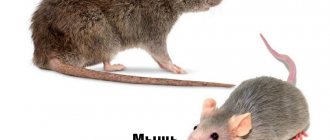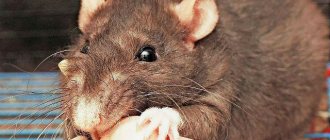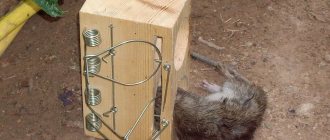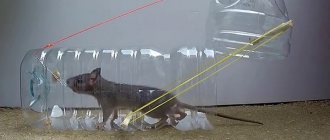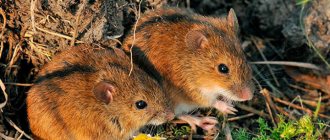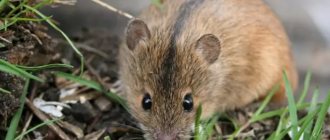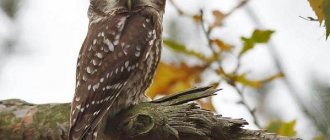The water rat - as people often call this furry animal - actually has a very distant relationship with rats. Biologically, it is closest to hamsters, although it has more impressive dimensions, as well as a long, bare tail (for which it is nicknamed “rat”).
The real name of this animal is water vole. Due to its habitat in coastal areas and its ability to swim and dive well, inexperienced summer residents often confuse the vole with a muskrat or nutria. Indeed, at a quick glance, there is a slight similarity between these rodents, but the vole is a completely different animal. It is much smaller than its “distant relatives” (up to 20 cm long, up to 300 g in weight), distinguished by short ears that almost do not protrude from the fur and a long, round cross-section (not flattened) tail. The length of the tail in different individuals can be up to 2/3 of the length of the body; it is not naked, but covered with sparse hair.
The water vole's fur itself is thick, gray or reddish-brown, the belly is usually lighter than the back. At one time in Russia, the vole was officially considered a commercial fur-bearing animal, whose skins were used to make clothing and accessories.
What does a water vole look like (photo)
Water vole.
Name: Water vole, European water rat Lat.:
Arvicola amphibiusClass: Mammals - Mammalia Order: Rodents - Rodentia Family: Hamsters - Cricetidae
| Habitats: | garden |
| Nutrition: | young shoots, roots, insects |
| Peculiarities: | swims well and quickly, and comes to people only in case of severe hunger. |
Work and career
In her work, the Rat is responsible and diligent; her hard work and perseverance allow her to achieve high positions and a good position. Rats often make successful careers and become leaders in areas such as politics, law, and entrepreneurship. They also produce talented artists, screenwriters, and scientists. In general, the Rat is capable of achieving success in any activity in which it is engaged, thanks to its determination.
Celebrities of this sign
Pope John Paul I, William Shakespeare, Peter I, George Sand, Charlotte Brontë, Wolfgang Amadeus Mozart, Mikhail Glinka, Thomas Hardy, Raj Kapoor, Leo Tolstoy, Jules Verne, Yves Saint Laurent, Marlon Brando, Maurice Chevalier, Prince Charles, George G. Bush. Actors: Jude Law, Cameron Diaz, Eminem, Alena Babenko, Gwyneth Paltrow, Scarlett Johansson, Valeria Gai Germanika.
Description of the animal
Water rat: peaceful neighbor or pest.
The European water rat or water vole belongs to the hamster family and is the most harmful among its genus. It is distributed over most of Europe, almost throughout Russia, except for the Far East, Eastern Siberia and the Far North.
Outwardly, it looks like an ordinary rat, but it has a short muzzle with small ears. The body is oval, covered with silky long fur of a reddish-brown color, with short legs and a long tail. Its length can be 15-25 cm, maximum weight is about 300 grams.
The tail of this animal is noteworthy; it is covered with hair, and not bare, like some representatives of this species. It can reach 2/3 of the entire length of the mouse itself.
There was a time when the water vole was a fur-bearing animal and its skins were highly valued. Now they are no longer used in industry, so the population has grown significantly.
Habitat
The vole is a voracious rodent.
The water rat lives on the banks of rivers, lakes, and ponds. The reason for its relocation may be a flood of water in a reservoir or famine. Closer to autumn, she can settle in fields and vegetable gardens and breed her offspring there.
The water vole makes its burrows in dry grass or next to garden beds. During a season, she is capable of giving birth to two to four litters, each of which can contain up to 15 cubs.
In Holland, water rats cause great damage to tulip plants in winter by eating their bulbs.
Don't voles live near bodies of water?
Most often, that’s where it is. But high water or famine can force them to change their place of residence.
Do they bite humans?
This situation is possible. Rats can only attack when cornered and very scared. The mother, while protecting her offspring, can also go on the attack.
Small rat
The taxonomy of the rat does not end there; its continuation is the small rat. The Pacific or Polynesian rodent is found in the Philippines, New Zealand, as well as the countries of Asia and New Guinea. The habitat of the animal is forest and forest-steppe zones.
Depending on the distribution area, the length of the animal’s body varies. The animals inhabiting the mainland of the continent reach up to 15 cm, small rats living on the islands do not grow more than 11 cm. The weight of the animal is also small: only from 40 to 80 g. The fur of a small rodent on the back is brown, in the abdomen - light tones Its distinctive characteristics also include a pointed muzzle, large ears and short legs. The tail has a length commensurate with the size of the body, and is covered with scaly rings.
The diet of the small rat is very diverse, it includes: seeds, fruits and parts of plants, as well as insects, spiders, bird eggs and tiny chicks.
Small rats reproduce throughout the year; the reproduction process becomes especially active in the summer.
Decorative pets
What harm does it cause?
A rat can eat succulent shoots, earthworms, and tree bark. But she especially likes root vegetables and flower bulbs.
It sets up feeding tables in the burrows, carries food there, and prepares several kilograms of vegetables and plant rhizomes for the winter. The water rat also gnaws the bark on tree trunks.
Vole: an animal on land and in water.
There are several main factors that harm a person:
- The animal is constantly hyperactive, around the clock on land, in water and in trees.
- Most often, a vole settles in a colony and the entire family quickly damages the surrounding area.
- The rat does not know how to store provisions for itself, so in winter it likes to move closer to human possessions, where there is something to profit from. She loves eggs and insects.
- The colony easily gets into the vegetable storehouse and even into the cellar, quickly destroying the stored crop.
Are you afraid of rats?
Not really
Interesting to know!
If optimal conditions are created for the life of a mammal, the field mouse will multiply very quickly. Up to 400 pests can be counted on one hectare.
The pest rests calmly in its shelter during the daytime, and goes out hunting during the day. This is the second reason preventing the fight against the earth rat. The rodent can rarely be found within the city. The stronger representatives of the genus - gray rats - do not allow them into their abode. Yes, they don’t need to. Why leave so many attractive places to live? After all, the main source of food for rodents is in the garden plot - these are the roots of plants and flowers, and loose soil that does not impede their movement. Rats live in the ground, making holes and passages, cutting off the entire root system of plants encountered on their way. This is the third reason why it is difficult to control pests.
Treatment of premises from mice and rats
How to identify at the site
If there is a suspicion that there is a pest in the area, but you have not personally encountered one yet, you can observe the first signs.
- They leave behind so-called feeding tables - areas with the remains of gnawed plants and trampled paths to them.
- Molehills, marks on the ground surface, similar to mole pits, but asymmetrical and at different distances.
- These water rats love the young apple tree most of all; they eat its bark incredibly.
The water rat is a voracious neighbor.
Bait recipes
- Recipe No. 1: dilute 20-25 g of gypsum with 30-40 g of flour and a small amount of vegetable oil. The animal dies from the plaster, which begins to harden when it enters the stomach.
- Recipe No. 2: One part each of gypsum and fried bran and two parts lard. The resulting mixture must be divided into balls and placed in places where rats live.
- Recipe No. 3: combine 20 g of rosin with 20 g of powdered sugar and 15 g of borax.
- Recipe No. 4: Poisoned grain, bait made from it is most effective in the autumn.
- Recipe No. 5: Sugar and malt are mixed in equal proportions into a container with quicklime, and a bowl of water is placed nearby. The rat, having satisfied its hunger, will immediately want to drink. This action will be the final one in her life.
Water voles do not tolerate the smell of garlic, milkweed, blackroot and hazel grouse. A large number of such plants planted on the site will cause a mass exodus of rodents. To ensure the accuracy of the method, it is recommended to place nut leaves, fish heads, and cloves of garlic in the holes.
How to get rid of an animal
To combat water rats in the garden, shallow trenches are made around trees, into which a mixture of peat or ash with strong-smelling substances is poured. The trunk is tied with burlap or spruce branches.
You can dig deep fishing holes and place bait with poison or bleach on the bottom. They must be placed exactly this way, in holes, so that pets are not harmed.
It is worth using mole traps; they are placed at the entrance to a dug hole. In the same way, spring or arc traps and catch buckets are used.
If the area is large and is in a risk zone, it makes sense to install ultrasonic repellers, which also work on birds and moles.
Cats that catch rats will help get rid of these pests. Usually, water rats do not wander into an area where there are active cats and dogs.
folk remedies are also used
- rags soaked in machine oil are stuffed into the holes;
- pour stove soot diluted to the consistency of sour cream into the holes;
- pieces of singed rabbit skin are stuffed into holes;
- They use plants with thorns that cling tightly to the skin, and they are poured into holes.
How to get rid of rats in a barn
Rats in the barn scare the animals and steal eggs. You need to get rid of them quickly, but at the same time take care of the safety of other residents.
How to get rid of rats on your property
Rats on the site spoil crops, bulbs, roots and gnaw the bark or shoots of young trees. They must be removed quickly, without delay.
Pets in the fight against rodents
If you have a rat-catcher cat in the house, the problem with rodents can be solved very quickly. One or two cats that like to hunt will catch part of the rat population within a short period of time, and the rest will simply prefer to leave the area.
True, not all cats are able to take a rat. More often than not, dogs cope with this more successfully, especially those with well-developed hunting instincts. But, of course, you shouldn’t intentionally have an animal in your house just because rats have appeared on your summer cottage. It is better to borrow such a pet from your neighbors for a while.
Advice. If the cat is not taken out to the country, or does not leave the house when traveling outside the city, then the contents of the pet’s tray can be used to repel rats. Wood litter soaked in cat urine works especially well. It can be buried shallowly in holes around the site. The rat, digging holes in the ground, will stumble upon it. She will consider that a predator has appeared on the territory and will try to get away from there.
Traps
A mousetrap is the first thing that comes to mind when it comes to exterminating rodents. Modern manufacturers of traps for rodent pests can present many models.
The most effective and humane device is considered to be an ultrasonic repeller. The only drawback is the high cost.
All traps are divided into two types:
- fatal (all that remains is to remove the rodent carcass and throw it away from the house);
- humane live traps (a rat, falling into a trap, remains safe and sound).
The humaneness of the latest traps is called into question, since you will have to kill the animal yourself. By releasing it into the wild (even far from living quarters), you will not protect your house and garden from further attacks.
Basic trap mechanisms:
- Electric trap. Battery operated. Installed in a living room, barn or garden. The animal dies from an electrical discharge. The indicator indicates the presence of a victim inside. The disadvantage is the rather high cost.
- Spring trap. A classic device for catching mice. The trigger mechanism pinches the rodent, breaking its spine. Most often this leads to the rapid death of the victim. Disadvantage: The trap often kills birds and injures small pets.
- Live trap. It is a box with bait inside. After touching the food, the door closes behind the rat.
Preventive measures against voles
In addition to using various baits, be sure to keep the area clean; In late autumn, in order to protect against frost and pests, tie tree trunks with covering materials. After every big snowfall on thaw days, the snow around the trees needs to be trampled down: compressed, after a cold snap, it becomes an insurmountable obstacle for rodents.
When removing dead animals from the territory, you should remember that they are carriers of tularemia, a dangerous infectious disease. Therefore, under no circumstances should you pick up a vole with your hands.
Subsequently, in order to prevent water voles from entering the landscaped area, it is recommended to erect a fence on a solid, deep (at least 40 cm) foundation. It is important to ensure that there are no gaps in the fence sections or attachment points through which water voles could enter.
Nutrition
Dumbo rats, like all other rat breeds, are omnivores, which means they will eat anything and everything. It is best to start with grain mixtures. If your rat is a picky eater and likes to eat selectively, then look for grain mixtures where all the good stuff is mixed together. Follow the instructions on the package when deciding how much food to give your rat. It is also not recommended to use food made for other rodents. The food will not contain the nutrients your pet needs.
In addition to formula, you can supplement your rat's diet with fruits, vegetables, and plenty of protein. Rats need a high protein diet, and boiled eggs or boiled chicken are two treats they love. Carrots and apples are also favorite foods. Try not to give your rat too much fruit, as the sugar can be detrimental to their health in the long run.
Rats are not fed the following foods:
- chocolate;
- raw potatoes;
- bean curd;
- legumes;
- blue cheese;
- sausages;
- green banana;
- spinach.
With caution, rats are fed the following foods:
- beet;
- almond;
- turnip;
- pumpkin and sunflower seeds (no more than 15 pieces, as they contain fats that can lead to the development of diseases);
- radish;
- cucumber;
- cheese (no more than twice a week);
- sour cream (this is a fatty product, so the rat can be given no more than once a week);
- eggs (this is a delicacy for rats, which can be treated no more than once a week).
Rats also need plenty of water, so make sure their water bottles are kept topped up and the water inside is clean.
Krawczyk (snow beetle)
A representative of the dung beetle family. Only it differs from its relatives in that it feeds on herbivorous food. It was nicknamed the shear beetle because it literally cuts off plant stems with its powerful jaws.
The beetle is black, up to 2.5 cm in length. Its head is large and very noticeable, for which it is also called the bigheaded fish.
Red minnows dig deep burrows for themselves, which are quite complex and large. This happens mainly in early spring, during the mating period. Then the female begins building a burrow. A common, not yet branched burrow sometimes reaches up to 70 cm in depth.
